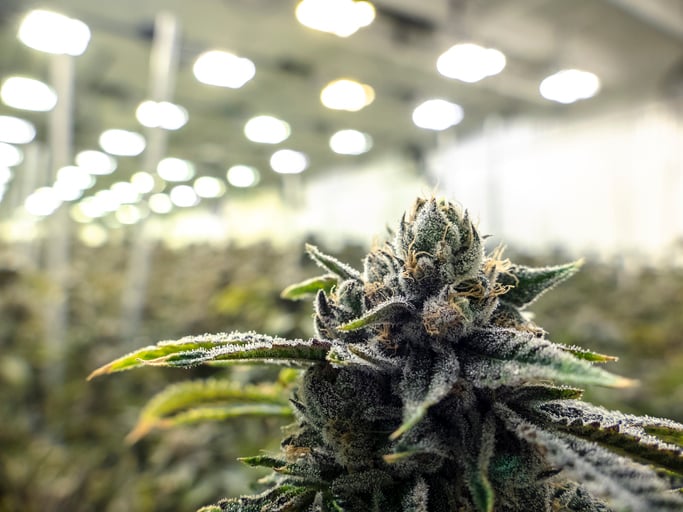The marijuana industry is expected to be a big-money business, and all eyes are on Canada. That's because Canada became the first industrialized country in the world -- and only the second country overall (behind Uruguay) -- to legalize recreational marijuana this past October.
In the grand scheme of things, Canada isn't expected to be a big-time cannabis player, with most estimates calling for anywhere from $5 billion to up to $10 billion in annual sales in five to 10 years. That compares to expectations for as much as $100 billion in cannabis and cannabinoid-based sales in the United States in 10 years. Nevertheless, Canada is the world's cannabis guinea pig of sorts and is almost certainly setting the foundation for future legalizations around the world.

Image source: Getty Images.
Adding up legal weed sales in Canada since legalization day
Of course, dealing with a relatively nascent industry comes with its bumps in the road. Although marijuana sales in licensed cannabis stores have been on the rise for three consecutive months, through May 2019, according to newly released data from Statistics Canada, pot revenue is still lagging Wall Street's initial forecasts. Here's a rundown of total licensed marijuana sales in Canada since recreational sales began on Oct. 17, 2018 (Statistics Canada reports in Canadian dollars, with U.S. dollar equivalency in parenthesis):
- October 2018: CA$53.68 million ($41.06 million)
- November 2018: CA$53.73 million ($41.1 million)
- December 2018: CA$57.34 million ($43.86 million)
- January 2019: CA$54.88 million ($41.98 million)
- February 2019: CA$51.66 million ($39.52 million)
- March 2019: CA$60.94 million ($46.62 million)
- April 2019: CA$74.58 million ($57.05 million)
- May 2019: CA$85.65 million ($65.52 million)
As you can see from these figures, May was Canada's best month, with licensed stores logging better than CA$85 million in revenue, or a nearly 15% sequential quarterly increase from April.
On an aggregate basis (i.e., in the 7.5 months since Oct. 17, 2018), licensed cannabis stores have logged CA$492.46 million in sales ($376.71 million). Canada's recent double-digit sequential monthly sales progression would suggest (in my best guess) that it has a shot to land between CA$800 million ($612 million) and CA$900 million ($688 million) in revenue in its first full year of sales.

Image source: Getty Images.
Here's why Canada's recreational cannabis launch quickly lost its buzz
Although Canadian cannabis sales are finally headed in the right direction, even CA$900 million in first full-year sales would almost certainly be considered a disappointment. This sales weakness can be specifically traced to three factors.
A sizable portion of the blame lands with regulatory agency Health Canada, which has been absolutely bogged down by licensing applications for cultivation, processing, and sales. Health Canada began the year with over 800 licensing applications for review (mostly for cultivation), but has approved fewer than 200 license holders since 2013. This can lead to cultivation and sales license wait times of months to more than a year. Even with recently announced license application changes, it's going to take some time for Health Canada to work through this enormous backlog.
To further build on this first point, Health Canada recently announced that high-margin derivatives, such as vapes, edibles, and infused beverages, won't be reaching licensed cannabis store shelves until mid-December, at the earliest. Previous expectations had these products hitting the market no later than October 2019, if not sooner.
The second issue has been on the packaging side of the equation. There are stringent rules regarding packaging and branding for cannabis products, and ancillary players that provide these solutions simply haven't been able to keep up with growing demand. This has left raw cannabis sitting on the sidelines since there's a shortage of compliant packaging solutions.

Image source: Getty Images.
The third problem relates to the growers themselves. None were particularly willing to outlay tens or hundreds of millions of dollars to expand production capacity until they knew with certainty that the Cannabis Act would become law. After all, Prime Minister Justin Trudeau had been promising to legalize marijuana for years without any real progress. With that near-certainty not coming until very late in 2017, it gave growers limited time to get their licensing in order and complete construction of growing facilities.
Though all of these issues are fixable, it will take time. That means a slow and steady progression in sales should be expected in Canada, and not the exponential surge that Wall Street had initially forecast.
Pot stock quarterly reports should improve, but not by much
While it is encouraging to see licensed cannabis sales hit an all-time high three months in a row, this slow-but-steady improvement isn't going to be of significant help to the largest and most popular cannabis stocks, such as Canopy Growth (CGC 6.43%) and Aurora Cannabis (ACB 1.61%).
Canopy Growth is in the midst of a pretty substantial shake-up that saw its visionary co-CEO, Bruce Linton, get fired from his post after the company reported a whopping net loss of CA$670 million in fiscal 2019. Linton's vision was always one of laying the infrastructure needed to be successful globally and in the United States. That meant spending aggressively and rewarding employees with long-term-vesting share-based compensation. Unfortunately, this spending pushed costs through the roof and looks to have cost Linton his job. As a reminder, following Constellation Brands' CA$5 billion investment in Canopy, it netted itself a core position on Canopy's board, allowing for the ability to push out Linton.
Canopy's fiscal first-quarter operating results, which will cover the April through June quarters, is not expected to show much in the way of sales or margin improvement, according to the company and CFO Mike Lee. Canopy Growth is fairly leveraged to the recreational side of the market, which is where many of the supply issues mentioned earlier have stymied sales. In other words, losses are expected to continue throughout 2020, and perhaps into 2021.

Image source: Getty Images.
Things have been looking a bit brighter for Aurora Cannabis, compared to Canopy Growth, but that's not exactly a ringing endorsement.
The bright side for Aurora Cannabis is that its production expansion and licensing look to be on track. Although a number of its larger facilities are still under construction, it's the clear leader in annual run rate output at north of 150,000 kilos, and should be on pace for at least 625,000 kilos of yearly run rate production by the end of fiscal 2020 (June 30, 2020). Simply having the output available will be a positive, although supply channels may still be working out the kinks even a year from now.
Perhaps the biggest concern for Aurora Cannabis is its international strategy. Don't get me wrong, international cannabis sales are the long-term catalyst for Aurora. However, these overseas sales aren't expected to really take off until domestic demand is satiated. Given the noted supply and packaging problems, it could be some time before that happens. This may relegate Aurora to yet another year of losses in 2020.
Obviously, the cannabis space remains fluid and a lot could change between now and even the next quarter. But as things stand at this very moment, pot stocks could continue to disappoint in the interim on the back of weak operating results.







